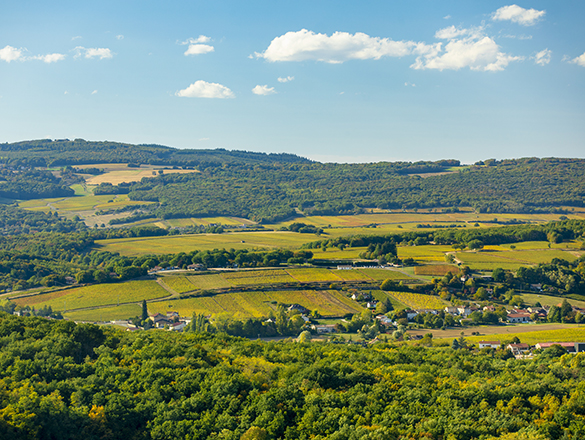
The vineyards of Bourgogne produce some great wines with a historical and international reputation. However, the region is not simply limited to its iconic appellations. In addition to its Village Premier Cru and Grand Cru AOCs, it also produces a range of wonderful Régionale and Village appellations to explore.
You will also find a full list of the Bourgogne’s Climats and lieux-dits on this page.
Check out the complete list of the 84 Bourgogne appellations.
However, your exploration has only just begun. Bourgogne wines have never before offered such high quality. Besides our range of internationally celebrated wines, try some of our lesser-known appellations where there are lots of surprises in store.
And for a fun way to find out more about the wines on offer, try out our “Which Bourgogne wine is right for me?” quiz, or check out Bourgogne Maps to take an interactive tour of the region.
Regional Appellation
VIGNOBLE DU MÂCONNAIS
31 juillet 1937
White: Chardonnay
Red and rosé: Gamay
Area under vine:
White: 484 hectares
Red and rosé: no plantation
Note: Average over three years 2016-2018
An additional geographical denomination that is part of the Régionale Mâcon appellation in the Mâconnais. According to the 2005 specifications rules, the name Mâcon-Lugny refers to red, white, and rosé wines grown within a defined area in the villages of Bissy-la-Mâconnaise, Lugny, Saint-Gengoux-de-Scissé, and part of Cruzille.

The whites are dry, with a pale gold color and hints of green. The nose is expressive, offering floral aromatic sophistication with notes of acacia and lily-of-the-valley, with citrussy touches of lemon and grapefruit. The nose then evolves to reveal hints of honey and quince, bringing a complexity to this wine. In the mouth, it is smooth, leading to a marked length, in particular after 3-5 years ageing. The wines then tend to reveal aromas of candied fruit and sometimes tropical fruit.

White: For a perfect flavor combination given the liveliness of this wine on the tongue, opt for an appetizer like a creamy leek tart or risotto verrine. Then allow its acidulated structure to cut through the parsley butter of razor fish à la plancha, gratinated oysters, or snails.
Serving temperatures: 10-11°C as an aperitif, 11-12°C with food

Located in the central Mâconnais, the vines of Mâcon-Lugny extend on the western side across the slopes of the valley of Saint-Gengoux-de-Scissé, opening to the south and north towards the appellations of Mâcon-Azé, Mâcon-Cruzille, and onto those of the valley of Lugny, closed off to the south, but extending north onto the slopes of Mâcon-Chardonnay.
A powerful 12th century chatelain and fief of the chivalrous lineage of the same name, the seigneury of Lugny shared jurisdiction and taxes in “wheat, rye, oats, and wine” with the religious establishments of Mâcon and Cluny, established since the 10th century in Saint-Gengoux-de-Scissé.
It was here that Henri Boulay and other winegrowers who were struggling due to poor sales founded the first cave cooperative in this part of Bourgogne in 1926, soon followed by the winemakers of Lugny. In 1950, these visionaries began campaigning for higher quality production with the Chardonnay varietal, “The preferred plant for this land.” As volumes increased, during the 1970s it was possible to conquer more distant markets, which helped boost the notoriety of Mâcon wines across the Atlantic.

The area covered by the Mâcon-Lugny appellation is a concentration of the topographical configuration of the central Mâconnais, with a complementarity between slopes and plateaus where the geo-climatic environment offers a compromise between the cool of the Haut-Mâconnais and the more southerly weather felt in the area immediately around Mâcon. Between these south-southwest/north-northeast relief lines, the vines grow at between 235 and 380 meters above sea level, alongside the nearby woods.
The vines cover the east-facing slopes in the lieux-dits of Le Climat, Saint-Pierre, and Les Fiez; the other side of the slope facing the setting sun in Les Crays; and the berms of Beluzes, Brinchamps, Charmes, and Genièvres. The terrain is made up of fine, pale limestone, “caille” stones that explode when heated, and marl or even siliceous marl, covering the geological substrate from the Middle and Upper Jurassic, from between 151 and 172 million years ago.
